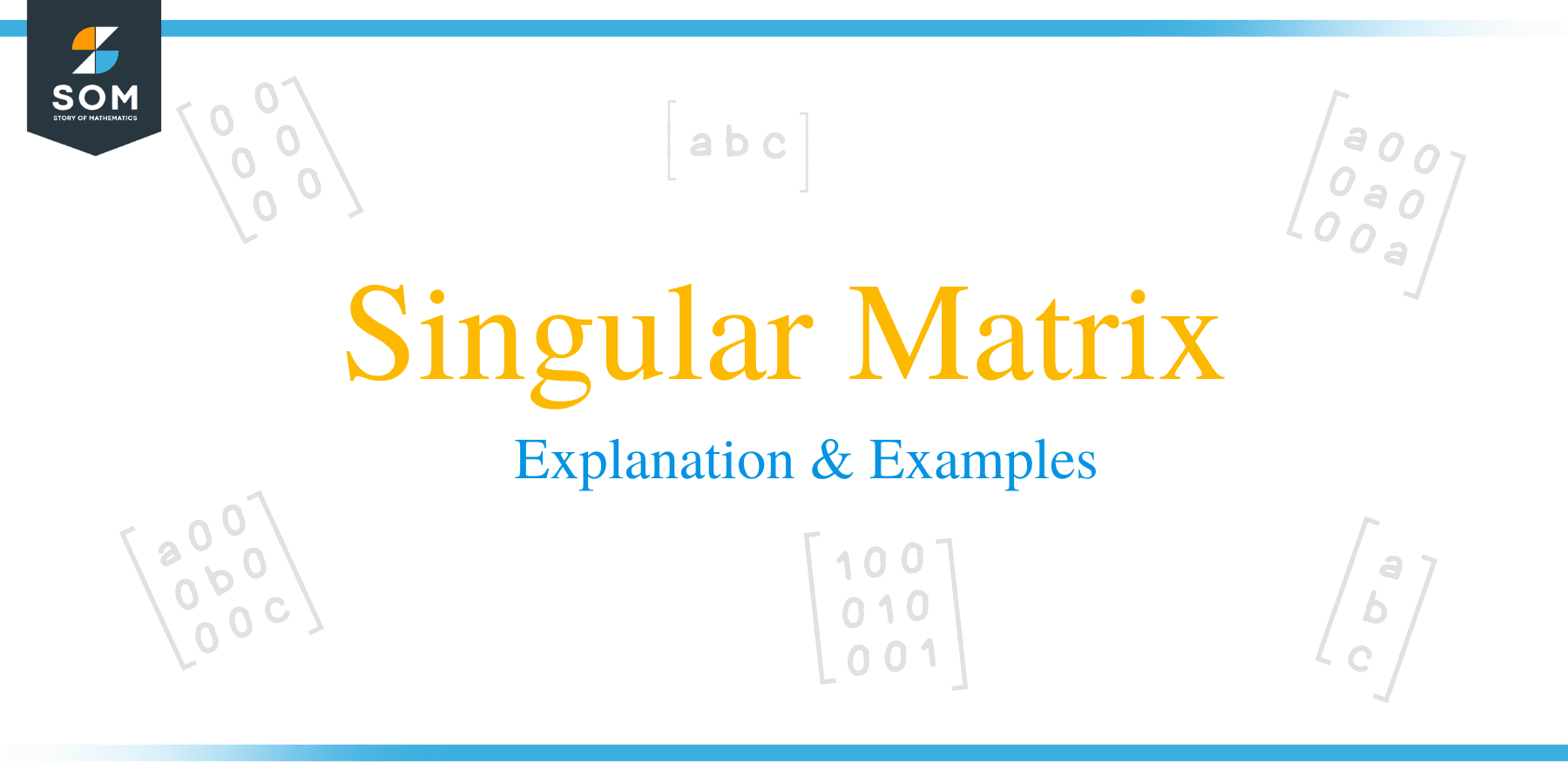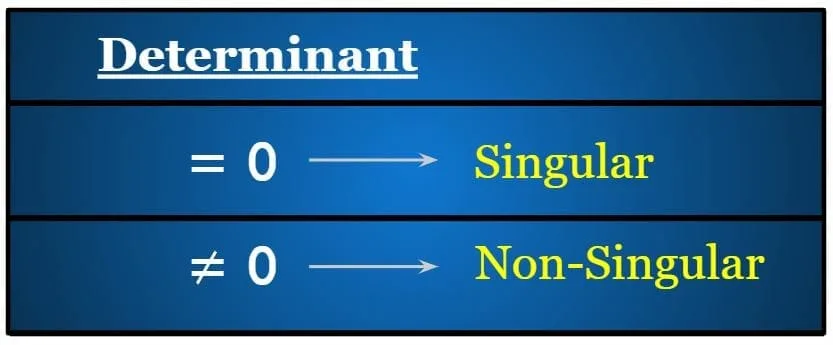- Home
- >
- Singular matrix – Explanation & Examples
JUMP TO TOPIC
Singular Matrix – Explanation & Examples
 A singular matrix is a very simple matrix. Though simple, it has immense importance in linear transformations and higher-order differential equations. But for this topic, we will look at it from a much lower level of mathematics.
A singular matrix is a very simple matrix. Though simple, it has immense importance in linear transformations and higher-order differential equations. But for this topic, we will look at it from a much lower level of mathematics.
Let’s check the formal definition of a singular matrix:
A matrix whose determinant is $ 0 $ and thus is non-invertible is known as a singular matrix.
In this lesson, we will discover what singular matrices are, how to tell if a matrix is singular, understand some properties of singular matrices, and the determinant of a singular matrix. Let’s start!
What is a Singular Matrix?
Simply put, a singular matrix is a matrix whose determinant is $ 0 $. Since the determinant is $ 0 $, we can’t find the inverses of such matrices. Thus, it’s a non-invertible matrix. A singular matrix is also known as a degenerate.
 Matrices whose determinant is $ 0 $ are called singular matrices, and matrices whose determinant is non-zero are called non-singular matrices.
Matrices whose determinant is $ 0 $ are called singular matrices, and matrices whose determinant is non-zero are called non-singular matrices.
Determinant of a Singular Matrix
From the definition of a singular matrix, we know that a singular matrix’s determinant is ZERO!
Singular matrices are square matrices whose determinant is $ 0 $. Consider Matrix $ A $ shown below:
$ A = \begin{bmatrix} { a } & { b } \\ { c } & { d } \end {bmatrix} $
It is a $ 2 \times 2 $ square matrix. The determinant formula for a $ 2 \times 2 $ matrix is:
$ det( A ) = | A | = ad – bc $
Now, let’s take a matrix with values. Consider Matrix $ B $ shown below:
$ B = \begin{bmatrix} { 1 } & { 2 } \\ { 4 } & { 8 } \end {bmatrix} $
What is the determinant of this matrix?
Let’s calculate the determinant of Matrix $ B $ by using the formula:
$ det( B) = | B | = ad – bc $
$ | B | = ( 1 )( 8 ) – ( 2 )( 4 ) $
$ | B | = 0 $
The determinant of matrix $ B $ is $ 0 $. Thus, this is a singular matrix!
Let’s consider the $ 3 \times 3 $ matrix shown below:
$ B = \begin{bmatrix} a & b & c \\ d & e & f \\ g & h & i \end {bmatrix} $
It is a $ 3 \times 3 $ square matrix. The determinant formula for a $ 3 \times 3 $ matrix is:
$ det( B ) = | B | = a \begin{vmatrix} { e } & { f } \\ { h } & { i } \end{vmatrix} – b \begin{vmatrix} { d } & { f } \\ { g } & { i } \end{vmatrix} + c \begin{vmatrix} { d } & { e } \\ { g } & { h } \end{vmatrix} $
$ | B | = a ( e i – f h ) – b (d i – f g ) + c (d h – e g ) $
Now, let’s take a matrix with values. Consider Matrix $ C $ shown below:
$ C = \begin{bmatrix} 1 & 1 & 1 \\ 2 & 3 & 1 \\ { 0 } & { – 1 } & 1 \end {bmatrix} $
What is the determinant of this matrix?
Let’s calculate the determinant of Matrix $ C $ by using the formula:
$ det( C ) = | C | = a ( e i – f h ) – b (d i – f g ) + c (d h – e g ) $
$ | C | = 1 [ ( 3 )( 1 ) – ( 1 )( – 1 ) ] – 1 [ ( 2 )( 1 ) – ( 1 )( 0 ) ] + 1 [ ( 2 )( – 1 ) – ( 3 )( 0 ) ] $
$ | C | = 1 [ 3 + 1 ] – 1 [ 2 ] + 1 [ – 2 ] $
$ |C | = 4 – 2 – 2 $
$ | C | = 0 $
The determinant of matrix $ C $ is $ 0 $. Thus, this is a singular matrix!
How to tell if a Matrix is Singular
Sometimes we are working with a problem that tells us to find the inverse of a square matrix. The first step we should do is to find the determinant. Then we plug the value into the matrix inversion formula and find our inverse matrix.
What if the determinant is $ 0 $?
Because the matrix inversion formula has $ \frac{ 1 }{ determinant } $ term, we can’t find the inverse of the determinant is $ 0 $ because we will have division by $ 0 $! This is undefined!
So, we then conclude that the matrix we are working with is a non-invertible matrix. It doesn’t have an inverse.
This specific type of square matrices is known as singular matrices!
To find if a matrix is singular or non-singular, we find the value of the determinant.
- If the determinant is equal to $ 0 $, the matrix is singular
- If the determinant is non-zero, the matrix is non-singular
Of course, we will find the determinant using the determinant formula depending on the square matrix’s order.
For a $ 2 \times 2 $ matrix:
Given,
$ A = \begin{bmatrix} { a } & { b } \\ { c } & { d } \end {bmatrix} $
The determinant is $ | A | = ad – bc $.
Matrix $ A $ is singular if and only if $ | A | = ad – bc = 0 $.
For a $ 3 \times 3 $ matrix:
Given,
$ A = \begin{bmatrix} a & b & c \\ d & e & f \\ g & h & i \end {bmatrix} $
The determinant is $ | A | = a ( e i – f h ) – b (d i – f g ) + c (d h – e g ) $.
Matrix $ A $ is singular if and only if $ | A | = a ( e i – f h ) – b (d i – f g ) + c (d h – e g ) = 0 $.
Singular Matrix Properties
There are a few properties we are going to state for singular matrices. They are given below:
- The determinant of a singular matrix is equal to $ 0 $. If we have Singular Matrix $ A $, then $ det(A) = 0 $.
- A non-invertible matrix (a matrix whose inverse doesn’t exist) is referred to as a singular matrix.
- Singular Matrices are only defined for square matrices.
- Singular matrices don’t have multiplicative inverses.
Let us check out some examples to enhance our understanding further. There are a few practice problems for you as well.
Example 1
Which of the following statements about singular matrices is false?
- The matrix has no inverse.
- The matrix’s determinant is $ 0 $.
- The matrix is invertible.
- The matrix can’t be multiplied with other matrices to achieve the compatible identity matrix ($ I $).
Solution
If you look at the properties of singular matrices, you will figure out that the determinant of a singular matrix is $ 0 $, which makes the matrix non-invertible. So, Option C is false.
Example 2
For the $ 2 $ matrices shown below, check whether they are singular matrices or not.
$ A = \begin{bmatrix} { 6 } & { -3 } \\ { 4 } & { -2 } \end {bmatrix} $
$ B = \begin{bmatrix} 0 & 1 & -1 \\ 1 & 4 & 0 \\ 3 & -1 & 1 \end {bmatrix} $
Solution
Calculating the determinant will tell us whether Matrix $ A $ and $ B $ are singular or not. Let’s calculate the determinant of Matrix $ A $:
$ | A | = ad – bc $
$ = (6)(-2) – (-3)(4) $
$ = -12+12 $
$ = 0 $
Matrix $ A $ is a singular matrix.
Now, let’s calculate the determinant of Matrix $ B $:
$ |B| = a ( e i – f h ) – b (d i – f g ) + c (d h – e g ) $
$ | B | = 0 [ ( 4 )( 1 ) – ( 0 )( – 1 ) ] – 1 [ ( 1 )( 1 ) – ( 0 )( 3 ) ] + (-1) [ ( 1 )( – 1 ) – ( 3 )( 4 ) ] $
$ | B | = -1(1) -1(-13) $
$ |B | = -1 + 13 $
$ | B | = 12 $
Since the determinant isn’t $ 0 $, Matrix $ B$ is a non-singular matrix.
Practice Questions
- For the $ 2 $ matrices shown below, comment whether they are singular or not.
$ A = \begin{bmatrix} { -1 } & { 2 } \\ { -2 } & { 4 } \end {bmatrix} $
$ B = \begin{bmatrix} { -6 } & { -15 } \\ { -4 } & { 10 } \end {bmatrix} $ - What value of $ y $ will make the matrix $ C = \begin{bmatrix} { 10 } & { -2 } \\ { y } & { -1 } \end {bmatrix} $ singular?
Answers
- We check the determinant of each matrix. If it’s $ 0 $, then it is a singular matrix. Finding the determinant of Matrix $A$:
$ | A | = ad – bc $
$ = (-1)(4) – (2)(-2) $
$ = – 4 + 4 $
$ = 0 $
Matrix $ A$ is singular.Now, calculating the determinant for Matrix $ B$:
$ | B | = ad – bc $
$ = (-6)(10) – (-15)(-4) $
$ = -60 – 60 $
$ = – 120 $
Matrix $ B $ is not singular. - For Matrix $ C $ to be singular, we have to equate the determinant equation to $ 0 $. Then use some algebra to solve for $ y $. The process is shown below:
$ | C | = 0 $
$ ad – bc = 0 $
$ (10)(-1) – (-2)(y) = 0 $
$ -10 + 2y = 0$
$ 2y = 10 $
$ y = \frac{ 10 }{ 2 } $
$ y = 5 $
